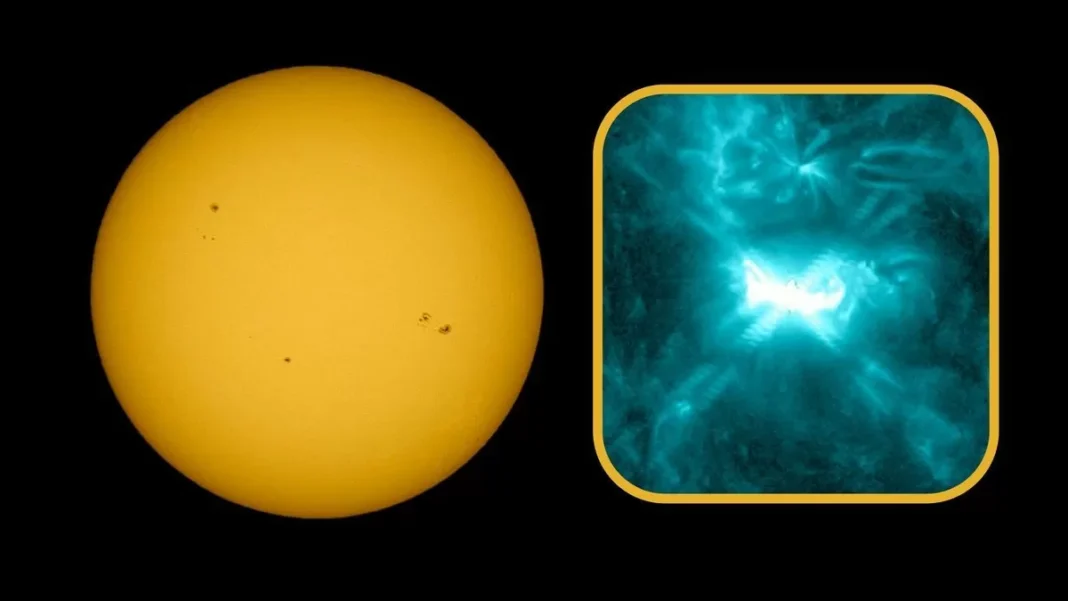After a period of relative calm, the Sun has once again reminded us of its powerful and unpredictable nature. On August 3-4, 2025, three M-class solar flares erupted from active sunspot region AR 4168, releasing intense radiation and causing disruptions in high-frequency radio signals. This event serves as a reminder of the Sun’s potential to impact our daily lives and the importance of continued research and monitoring.
The Sun is a massive, ever-changing star at the center of our solar system. It is constantly emitting energy in the form of light, heat, and radiation. Occasionally, it also releases bursts of energy called solar flares. These flares are caused by the sudden release of magnetic energy in the Sun’s atmosphere, resulting in a bright flash of light and intense radiation.
For the past 22 days, the Sun has been relatively quiet, with no major solar flares reported. However, on August 3-4, that changed when three M-class solar flares erupted from active sunspot region AR 4168. These moderate flares were not as powerful as some of the larger X-class flares, but they still released intense radiation that could have potentially disrupted high-frequency radio signals and sparked auroras at high latitudes.
The sunspot region AR 4168 has been closely monitored by scientists for its potential to produce solar flares. Sunspots are areas on the Sun’s surface that appear darker because they are cooler than the surrounding areas. They are also regions of intense magnetic activity and can be the source of solar flares. AR 4168 has been particularly active, with multiple sunspots and a complex magnetic field.
Scientists were able to detect these solar flares using various instruments, including the Solar Dynamics Observatory (SDO) and the Solar and Heliospheric Observatory (SOHO). These satellites provide valuable data and images of the Sun, helping scientists understand its behavior and predict potential solar flares.
The three M-class solar flares released intense radiation, including X-rays and ultraviolet light, which can have a significant impact on Earth’s atmosphere. The radiation can cause disruptions in high-frequency radio signals, affecting communication and navigation systems. It can also pose a risk to astronauts and satellites in orbit.
One of the most fascinating phenomena associated with solar flares is the aurora borealis, also known as the Northern Lights. These colorful displays of light are caused by charged particles from the Sun interacting with Earth’s magnetic field. While the recent solar flares were not strong enough to produce a widespread aurora, there were reports of sightings in some high-latitude regions.
In addition to the solar flares, scientists also detected a likely coronal mass ejection (CME) associated with the event. A CME is a massive cloud of charged particles ejected from the Sun’s atmosphere, traveling at high speeds. If directed towards Earth, a CME can cause a geomagnetic storm, which can disrupt power grids and satellite communications.
The recent solar flares serve as a reminder of the Sun’s potential to impact our daily lives. While we have made significant advancements in predicting and understanding solar flares, there is still much to learn about this powerful phenomenon. Continued research and monitoring of the Sun are crucial for our understanding of its behavior and potential impacts on Earth.
Fortunately, we have a network of satellites and ground-based instruments dedicated to studying the Sun and its activity. These tools provide us with valuable data and images, helping us better understand the Sun’s behavior and predict potential solar flares. They also play a crucial role in space weather forecasting, which is essential for protecting our technology and infrastructure from the effects of solar activity.
In conclusion, the recent M-class solar flares from active sunspot region AR 4168 serve as a reminder of the Sun’s powerful and unpredictable nature. While these flares may have caused some disruptions, they also provide valuable insights into the Sun’s behavior and the importance of continued research and monitoring. As we continue to explore and understand our dynamic Sun, we must also take steps to protect ourselves from its potential impacts.


